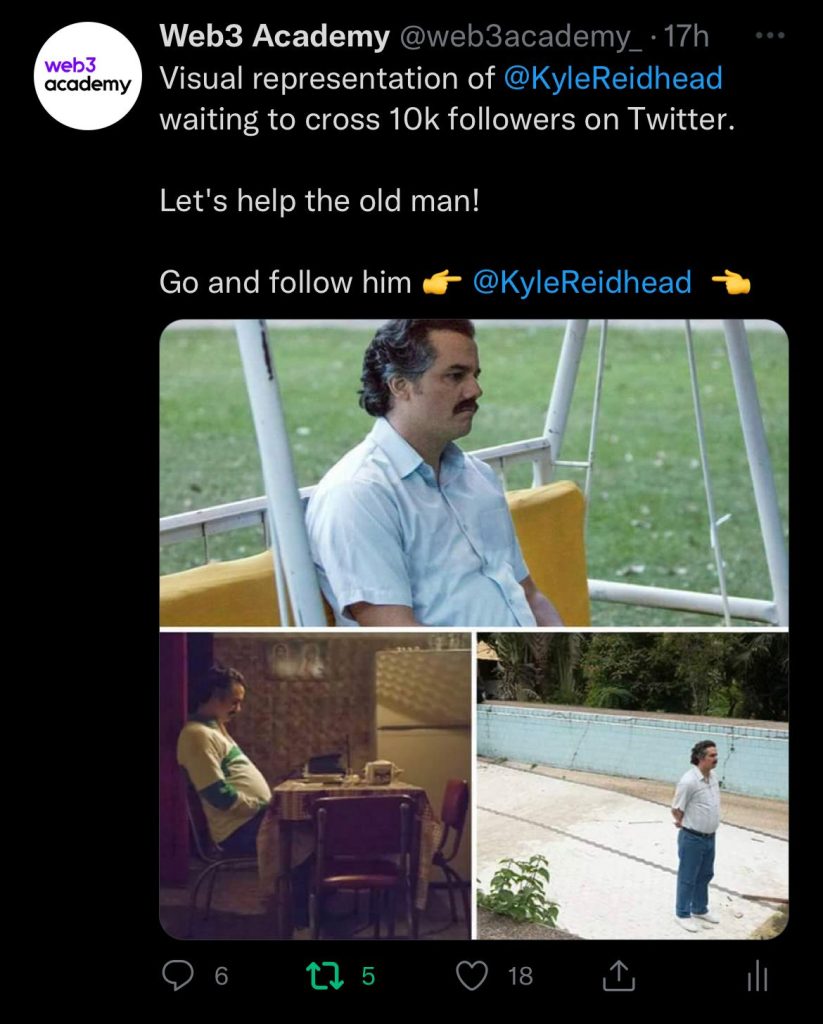
Here’s How Gaming Will Make Web3 Easy and Fun | Michael Sanders @ Horizon
Gm DOers!
Truthfully, using web3 today is a real pain in the butt…
You need:
👜 A wallet, which is a clunky experience,
☁️ A memory for 12-24 random words,
🔑 A safe to store your seed phrase,
📖 A Dictionary to understand the terms and the slang
🧑⚕️ And a therapist to ease the stress…
But this is normal… In fact, the internet was the same when it first came about. It was hardly used by regular people before apps like Facebook and Google came around to make everything easy.
We believe that gaming will be one of those catalysts that will onboard the next 100 million users into web3 by making it easy to interact with wallets, NFTs, staking, and so on…
To get a feel of how this will practically work, we sat down with Michael Sanders, the co-founder of Horizon, the creators of the leading blockchain game Skyweaver.
The Horizon team co-authored the ERC-1155 token standard which is often referred to as Semi-Fungible Tokens (SFTs). Don’t worry, we’re going to explain this at length throughout this article.
Here’s today’s outline:
🤔 Why are there not more people in web3?
🕹️ How will gaming onboard the masses?
🤷 What are SFTs?
Let’s go 👇
Wait 🚥 Not into reading? 📖
Sit back and watch on Youtube 👀 or listen on Spotify or Apple Podcasts 🎧
🥳 We’re now on TikTok 🥳
Web3 Academy is officially on TikTok, with the same mission: to guide entrepreneurs, businesses and creators into Web3… 🚀
We’ve listened to our community who suggested that we need to produce more short-form content… This is for you!
Now, we need your help in order to grow! If you’re on TikTok, go ahead and follow us @web3academy!
We will follow everyone back 👀
Why Are There Not More People in Web3?
We keep talking about how great web3 is, which use cases it unlocks and the impact it has and will have on the world in the future.
If that’s true, then why are there not more people in this space?
There are 3 reasons we only have about 100M people in web3 today:
- There’s not enough good content that breaks through to a mass audience.
- The UX sucks.
- It’s difficult for developers to build in web3.
There’s not enough good content that breaks through to a mass audience
In order to reach the masses, you need to provide super fun content. Gaming is one of the most engaging forms of content. As evidenced by global gaming revenue reaching an all time high of $215B in 2021.
Gaming is by far the largest category of the entertainment and media industry far surpassing video streaming ($79B), cinema ($46B) and music ($36B). Games like Fortnite, World of Warcraft and League of Legends have succeeded because regardless of their age, people have fun playing them.
If we’re going to onboard 1 billion people to web3 we need games that rival those of the web2 world. Furthermore we need games where NFTs, blockchain and crypto are not the focal point of the game but rather a feature that enhances game play. We need games that trojan horse users into web3 by giving them ownership of in-game items without them knowing they are using NFTs.
Current blockchain games are basic and often focused on the speculative side of crypto where users just want to make money. One of the few blockchain games that has achieved great success is Skyweaver. Reason being that this is a simple trading card game just like Magic the Gathering or Pokemon. It’s easy to understand for millions already playing trading card games where owning, trading and gifting cards is already part of the game.
It’s like an introduction to the masses to get familiar with digital ownership of game cards where they already understand physical ownership of game cards.
Over the next 12 months there will be many new blockchain games released from top publishers that have been in development for years. You can expect to see a wave of millions of new users onboarding to web3 through these games.
The UX sucks
Yes, we talk about this a lot. But it’s important to acknowledge. Otherwise, we won’t ever succeed.
Why are Facebook, TikTok and Gmail so successful? I’ll tell you: because their user experience is so freaking good.
All you need is an email address and there you go, you’re all set.
In web3, however, if you want to play a game like Axie Infinity or enter a Metaverse such as Decentraland, you need to have a wallet, you need to buy in-game currency and items, you need to pay gas fees, stake your tokens and so much more bulls**t that it makes the game unenjoyable.
Now, to be fair, the web3 UX doesn’t suck for everybody. The tech savvy people are doing just fine. But to onboard 1B people, it requires much more than what we currently have.
It’s difficult for developers to build in web3
It’s hard for developers to build in web3 right now. You need to learn a new language (solidity, rust, etc.) and you need to learn the mechanics of smart contracts.
Oh and if that’s not enough you also need to develop the standards and protocols to build on top of. Why? Because web3 infrastructure is only a few years old.
Michael and the Horizon team literally had to first build an ERC token standard so that they could then build game items on it.
And this is the reality right now. In web2, if you want to build a website for example, you go on WordPress and build it using a template. In web3, you need to build WordPress first.
Thankfully there are tools like Sequence being built to make it easier for developers to build web3 games and apps.
So how can we solve these problems?
Theoretically, it’s easy. Practically, it’ll take time and effort
- Start by building the infrastructure properly. I.e. build interoperable and open source standards, protocols and apps upon which anyone in the world can easily build. This will attract more and more developers towards web3.
- Focus on the UX. Unfortunately, projects cannot focus on this unless the infrastructure is laid out. Right now, blockchain developers are thinking more about how an application can work rather than how it should look.
- Focus on developing smart contract wallets. These are wallets that do not require users to store their private keys. One example is the sequence wallet, built by Horizon, which allows you to connect with the typical web2 login options. 👇
The masses are not in web3 yet because there’s friction. In other words, the UX is just plain bad. It’s bad because we need to focus on the infrastructure layer before designing a pleasant user experience.
Now, keep in mind that this isn’t the end of the world. Despite having horrible UX there’s still millions of people using web3 everyday and billions of dollars flowing from VCs into web3 businesses. This is a good sign! It means that web3 is legit. Something that people are so excited about that they are willing to look beyond the current UX.
This is a phase that all major technological innovations go through. Just think about online shopping in the beginning. It was a nightmare to use. But Amazon got better and better and now it’s simple and easy.
Web3 will get there too. And we believe that gaming will take it there. Let us tell you how 👇
🎉 Tweet Of The Week 🎉

How Will Gaming Onboard the Masses in Web3?
Let me start off with some stats. According to Statista, global gaming audiences spent an approximate $54B on additional in-game content. In 2025, the market value of in-game purchases is projected to surpass $74.4B.
The funny thing about in-game items in web2 games is that the users do not actually own them.
It’s true. If you buy a skin for your AK47 in Counter Strike, the game still owns that item and you can only sell it on the gray market. There’s no open marketplace.
Here’s how web3 fixes this:
👉 Before you read any further, tell us… Do you think gaming will be a catalyst of onboarding the masses into web3? Reply to this email with Yes or No and tell us what you think!
Own your in-game items
Through NFTs (or SFTs, which will be explained in section 3), you can own your in-game items in web3. This is absolutely huge! And makes gaming way more fun.
The existing games in web3 all offer an open marketplace where all in-game assets are on the blockchain, owned by the user and stored in the users’ wallet.
Once we start to develop games of the same quality as Web2, we will see gamers flock into web3. Owning your digital assets is truly a great unlock. Something that will definitely disrupt typical web2 games. Unless they disrupt themselves and implement web3 into their business models.
Create a sense of community
Owning your assets means that you own a piece of the game. When you own a piece of something, you want it to succeed. You become an ambassador for that game/brand.
Ownership builds community. It’s one the greatest unlocks of web3. A community essentially becomes your marketing army. Once game developers understand this, we’re going to see a great number of games showing up in the Web3 space.
Velocity rather than value extraction
The current business model of the biggest games in the world is to sell the game and then to additionally sell in-game items.
The entire focus is on value extraction. I.e how do I get this player to spend as much money as possible?
In web3, this focus changes towards velocity (the rate at which money changes hands within an economy) and symbiosis (a mutually beneficial relationship between different people or groups).
What this means is that game developers now focus on extracting value by charging a fee per transaction, in the form of royalties while allowing players to exchange goods with each other.
This creates an ecosystem where users own their assets. They can seamlessly sell or trade their assets with other players. The game grows with increased velocity of activity between players while the creators benefit from royalties on each transaction rather than extracting value from each individual player.
This changes everything. All of a sudden, the game and the players work together to grow under the same community. It’s extremely powerful.
😂 Meme Of The Week 😂

SFTs (Semi-fungible tokens) – The Key to the Success of Gaming in Web3
Let’s get back to basics… the infrastructure layer. As mentioned before, it’s vital to get this part right in order to attract more builders.
Right now, developers in web3 often have to first define the infrastructure before building… That’s what the Horizon team did – they co-authored a new token standard, ERC-1155.
It’s okay if you haven’t heard of this before… We’ve also just got them on our radar. Let us tell you what we know.
The ERC-1155 standard is behind the so-called semi fungible tokens (SFTs). These are used to enable game developers to build a web2-like experience in web3…
See, NFTs (ERC-721) are non-fungible tokens, meaning that each item in a collection is unique i.e. Bored Ape #7445 isn’t the same as #6588. They both have different looks, traits and value.
On the other hand, fungible tokens (ERC-20) are the same with each other having the same looks, traits and value, i.e 1 Bitcoin is always 1 Bitcoin.
And somewhere in the middle… semi-fungible tokens are born. To help you understand them, I will use Pokemon cards as examples.
Imagine a trading game where you have 10 equivalent Pikachu cards and 10 equivalent Charizard cards.
In order for the game to work, the Pikachu cards should be interchangeable (fungible) with each other but they should be different from the Charizard cards.
If you would use the NFT token standard for these cards, you would have to make each and every card unique i.e. the Pikachu cards would not be equivalent to each other hence why they won’t be interchangeable.
In a game where you have for example 1000 swords, you want all of those swords to be exactly the same to each other. And the NFT token standard cannot provide that.
NFTs are great for 1/1 unique arts or real estate but are limited when it comes to games for the reason mentioned above.
And SFTs seem to be fixing that problem. It’s a small adjustment to the typical NFT standard but it makes all the difference. 🚀
Conclusion
After our discussion with Michael, we realized how early web3 is… The infrastructure layer isn’t even close to being there…
We learned that in order to onboard the masses, we must focus on the basics.
The good thing about this is that people are already building:
🏗️ We’re seeing more and more devs coming over to web3 to build
☁️ Google (Cloud) is dipping its toes into the underlying tech of web3
🎮 Horizon is building games, marketplaces and wallets that are UX friendly
🙈 And Facebook is experimenting with NFTs
Hopefully, web3 gaming will be one of the catalysts that onboard the masses.
Regardless, we’re headed into the right direction and if you’re reading this, you’re already a step ahead of the mainstream population.
Thanks for reading, frens ✌️
Connect with Michael on Twitter
🚀 Action Steps For Web3 DOers 🚀
👉 By replying to this email with YES or NO, let us know if you think gaming will be a catalyst to onboarding the masses into web3
👉 Check out Horizon, experiment with the Sequence wallet, start playing the Skyweaver game and sell your SFTs on Niftyswap.
👉 Follow Web3 Academy on TikTok
👉 Make Kyle happy by helping him surpass 10k Twitter followers. Follow him now @KyleReidhead.










Responses